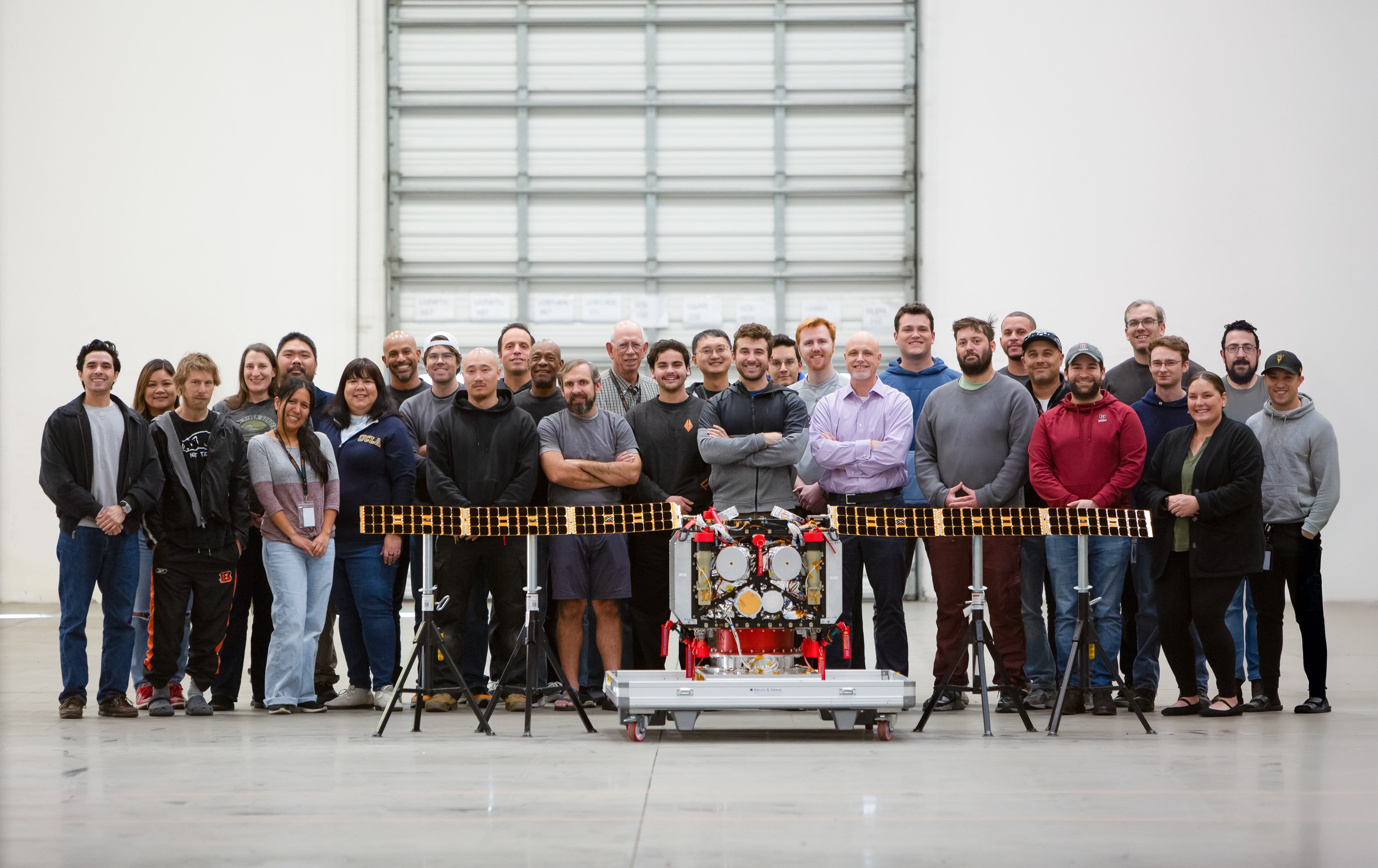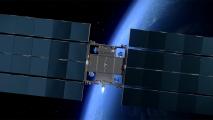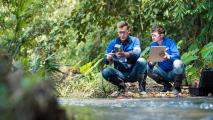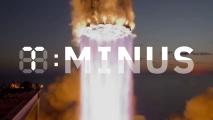It’s 2030. A shortage of rare metals needed to build many clean energy technologies threatens to stymie global decarbonization efforts, but thankfully, a mining startup just proved we can tap into a new source for the materials: asteroids.
Asteroid mining
Earth is an excellent provider for humanity.
Not only does it supply us with breathable air, liquid water, and the other basics that we need to survive, its crust also contains more than 90 elements in thousands of combinations. Over the millennia, we’ve mined the materials to make everything from arrowheads to smartphones.
To reach the next level of civilization, though, we might need to take our mining efforts off-world — and a space startup unlike any other aims to be the one to break that new ground.
Where we’ve been
About 2.6 million years ago, early humans started making tools out of the stones they could readily access on Earth’s surface. If they found stones that were particularly useful, they would use their hands or primitive tools to dig into the ground nearby in search of more like them.
This digging helped humans discover other useful materials that we could then mine. The mining of copper and other metals, for example, allowed us to build stronger tools and weapons and led us into the Bronze Age.
As the types of materials we mined evolved, so did our mining techniques.
Simple open-pit mines were joined by underground tunnels that gave us access to even more kinds of materials and in greater quantities. Stone shovels were replaced by stronger tools, and after using fire and water to crack rock for thousands of years, miners discovered in the 1600s that explosives were even more effective.

The Industrial Revolution brought mechanization to the mining industry, making it easier to extract and haul valuable materials, including the fossil fuels that are now the world’s most mined resources by volume. It also brought electricity, which meant light, better ventilation systems, and safer equipment.
Today, many mines are high-tech operations, with survey drones, autonomous trucks, and remotely operated drills. To combat climate change, some companies are replacing their diesel vehicles with battery-electric ones and building on-site solar and wind farms to power their operations.
To the prehistoric miners who dug for flint with their bare hands, these massive pits, metal birds, and autonomous machines would seem like sorcery or the work of the gods — but the reusable rockets poised to take mining to its next level would likely be beyond all comprehension.
Where we’re going (maybe)
To have a significant impact on climate change, we’re going to need to decarbonize a lot more than just mining, and many clean energy technologies, including solar panels and hydrogen fuel cells, require their own kind of mined resource: platinum group metals (PGMs).
“Platinum group metals are critical for today’s energy sector industrial base and will play a key role in tomorrow’s decarbonized economy,” according to the US Department of Energy (DOE).
However, these six metals (ruthenium, rhodium, palladium, osmium, iridium, and platinum) are among the least abundant elements on Earth, and extracting and refining them is a complex, expensive process that requires a lot of energy and water.
While the US does have a small domestic supply of PGMs, it relies heavily on imports to meet its demand, mostly from South Africa, which contains about 89% of the known PGM reserves.
The concentration of the world’s PGMs in just one location makes the supply chain susceptible to disruption, according to a 2022 report by the DOE, which also determined that the global supply of one PGM in particular — iridium — might not be adequate to meet the US’s decarbonization goals.
So, rather than continuing to rely on the Earth to provide the PGMs we need for the clean energy revolution (and many other applications), some people think we should start extracting the metals from asteroids.
“We already think we can do it for a better marginal cost than you can do it on Earth.”
Matt Gialich
Asteroids are the debris left over after our solar system formed billions of years ago, and scientific observations suggest that some of these space rocks contain iridium and other PGMs in much higher concentrations than we find on Earth.
If we can extract PGMs from the asteroids in our galactic neighborhood, we could not only shore up the supply, but also avoid the drawbacks of mining them on Earth (water pollution, carbon emissions from equipment, etc.), and thanks to reusable rockets, the cost of reaching these valuable space rocks has never been lower.
“We’re less than 10 years away from running out of iridium,” Matthew Gialich, co-founder and CEO of asteroid mining startup AstroForge, told Freethink. “Now maybe we’ll find a mythical ore deposit or maybe we’ll figure out how to mine 10,000 meters under the Earth, but the reality is it’s more economically feasible to mine in space at the point we’re already at.”
“We already think we can do it for a better marginal cost than you can do it on Earth,” he continued, “and at the end of the day, economics always wins.”

AstroForge isn’t the first to look at space rocks and see dollar signs — astrophysicist Neil deGrasse Tyson predicted in 2015 that the world’s first trillionaire will be “the person who exploits the natural resources on asteroids.”
It also isn’t trying to do something completely unprecedented. In 2010, JAXA successfully retrieved bits of an asteroid with its Hayabusa mission, and a decade later, it completed its second asteroid sampling mission. In 2023, NASA retrieved its first asteroid samples.
But these three missions have only managed to collect about 127 grams of material from asteroids — less than the weight of a baseball — and the process has been expensive. NASA spent more than $1 billion on the OSIRIS-REx mission that collected 121 of the 127 grams.
That sample was pulled from the asteroid Bennu and mostly contained water-rich clay minerals, but even if it had been pure rhodium — the most expensive PGM — it would only be valued at about $24,000.

An asteroid mining company is going to need to be able to collect much more material, much more cheaply in order to make a profit, but no private company has ever even reached an asteroid, let alone collected a sample from it — and this isn’t for lack of trying.
A decade ago, two promising startups, Planetary Resources Inc. (PRI) and Deep Space Industries, seemed well-positioned to be the first to mine a space rock, only to both fold before launching any missions to asteroids. AstroForge, meanwhile, has successfully launched two spacecraft since its founding in 2022, but neither mission went as planned.
The first, Brokkr-1, launched via a SpaceX Falcon 9 rocket in April 2023. It was supposed to demonstrate AstroForge’s refinery technology, but the company lost contact with the spacecraft before it could get that far.
Its second mission, Odin, was supposed to do a flyby of a metal asteroid so that it could take images for a future mining mission, but AstroForge lost contact with that probe about 20 hours after its March 2025 deployment via a Falcon 9, bringing the mission to an early end.
However, these setbacks aren’t stopping the startup from moving forward with its third mission, Vestri, which is set to launch in 2026.
During this mission, AstroForge will try to mine the asteroid that Odin failed to image.
Because metal-type asteroids are more than 90% iron, which is magnetic, the startup can take advantage of magnetism to help its spacecraft stick to the space rock, Jose Acain, AstroForge’s CTO and co-founder, told the Future of Space podcast in May 2024.
Once in place, a laser will vaporize part of the asteroid’s surface. AstroForge’s refinery technology will then use magnets to separate condensed nanoparticles of iron and other magnetic materials, which aren’t valuable enough to bring back to Earth, from the PGMs, which are not magnetic.
Demonstrating that this works is the goal of the Vestri mission. The startup won’t actually try to bring any asteroid samples home until its fourth mission, which Acain expects will launch about a year after Vestri.
“That’s a two-year round trip, but before the end of the decade, we’ll hopefully have return samples,” he told Future of Space.
“I don’t need to raise a billion dollars to launch.”
Matt Gialich
In the past, two failed missions would be enough to shutter some space startups, or at least make them take a beat before launching a third, but AstroForge is able to keep plowing ahead because it is moving faster and spending far less per launch than its promising predecessors — Odin took less than nine months to build, and the entire mission cost just $6.5 million.
“PRI and Deep Space Industries…failed primarily, in my opinion, because of timing,” Gialich told Freethink. “In 2008, 9, 10, when those companies were really starting to get in their big base of funding, it cost about $450 million to go to deep space. You’re not going to buy a $450 million rocket and put a $2 million satellite on it — that’s just completely stupid.”
“So, if you had a price comparison to the launch, you need almost a billion dollars to launch back then,” he added. “I don’t need to raise a billion dollars to launch…I think that is the biggest difference there as we go into it.”
“SpaceX, when it first started, was the riskiest shit in the world.”
Matt Gialich
Another difference is that AstroForge isn’t nearly as risk-averse as many others in the space industry.
While NASA goes to great lengths to mitigate every possible risk before launching a mission, even if it means extending the timeline and increasing the budget, AstroForge was willing to launch Odin, despite estimating the mission had just a 30% chance of success.
“We knew where all our weak points were,” said Gialich. “I think the magic here is we still were okay with flying it…We still said, ‘We got to try it. Let’s go for it and see what we learn.’”
“We’re going to make dumb mistakes,” he added. “We’re going to really screw up things that are pretty easy, but we recognize them, and we go fix them in a way that makes sense to us.”
This attitude of failure being an option would seem sacrilegious to many working in the public space industry, but SpaceX showed what could happen when you apply the “move fast and break things” ethos of Silicon Valley to aerospace: you get reusable rockets, the technology that could revolutionize mining in the 21st century the same way gunpowder did in the 16th.
“SpaceX, when it first started, was the riskiest shit in the world…You’ve got to have a little bit of [guts], in my opinion, to actually change the world,” Gialich told Freethink.
We’d love to hear from you! If you have a comment about this article or if you have a tip for a future Freethink story, please email us at [email protected].






